“`html

Fact Check: Is the US Prepared for Back-to-Back Disasters?
A DBUNK subscriber submitted a fact check request regarding CNN’s article on record-breaking cold and its impact on recovery efforts in flood-affected areas like Kentucky and West Virginia. The article reports on the devastating storms and frigid temperatures sweeping across the country, but does it provide complete and accurate information? Let’s analyze.
Misinformation and Missing Context
The article states that “three-quarters of the US population is expected to experience below-freezing conditions by Friday,” implying an unprecedented weather event. However, historical data from the National Weather Service shows that large portions of the US routinely experience similar cold outbreaks in winter months, making this claim somewhat alarmist without proper historical comparison.
Another significant gap in the article is the lack of data on how well-equipped Kentucky and West Virginia are to handle back-to-back disasters. The article mentions that emergency crews have conducted more than 1,000 rescues but does not provide crucial details about available resources, statewide emergency funding, or preparedness planning. This omission might leave readers with the impression that these states are entirely unprepared, when in reality, existing emergency management plans are in place but may be strained under current conditions.

Potential Bias and Sensationalism
The report repeatedly describes the flooding in Kentucky as “one of the most significant natural disasters we’ve seen in our lifetime.” While the damage is unquestionably severe, comparisons to previous natural disasters in Kentucky, such as the 2022 Eastern Kentucky floods, would provide essential perspective. Without such context, the claim leans toward sensationalism, making the situation appear uniquely catastrophic when similar extreme weather events have occurred within recent years.
The phrase “temperatures will plunge as much as 50 degrees below February averages” is another example of exaggeration. Weather records indicate that temperature departures from the norm can vary drastically across regions. While temperatures may locally hit those extremes, the way it’s framed suggests a nationwide crisis, when in reality, not every area will see such drastic deviations.

How Prepared Are Kentucky and West Virginia?
Since readers are concerned about state preparedness, it’s important to highlight that Kentucky and West Virginia have experienced multiple severe weather events in the past five years, prompting updates to their emergency response plans. According to FEMA and state emergency agencies, Kentucky has expanded disaster relief budgets and streamlined its emergency response coordination following the 2021 and 2022 severe floods.
West Virginia has similarly adjusted its infrastructure funding to reinforce affected regions, meaning that while recovery remains challenging, both states are not unprepared. However, resource limitations in rural areas continue to be a concern, particularly when disasters strike in quick succession.

Final Verdict
The CNN report accurately presents the dangers of the cold weather and ongoing flooding but lacks essential context regarding historical temperature trends and state preparedness efforts. Some claims lean toward sensationalism, which can create unnecessary panic. More balanced reporting that includes government response measures and historical data would help paint a clearer picture of the situation.
Have an article you need fact-checked? Join our community by downloading the DBUNK app and submitting your request. We cut through misinformation to bring you the full story.

